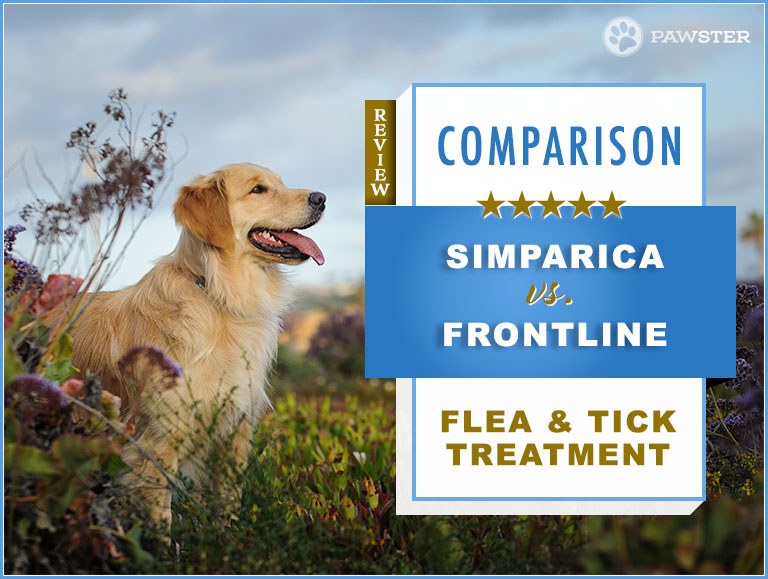Simparica vs. Frontline : Comparison and Key Differences

Contents of Article
Chewables and spot-on treatments can difficult to sort out, but we’ve got some information to help you figure out which type of treatment works best for you. Some pets will thrive with topical treatment, and some will benefit strongly from a chewable.
However, for this article it’s not a matter of which type is better. Depending on your pet’s lifestyle, you may need a chewable for the ease and lack of mess, or you may want to give spot-on treatments a try if your dog is a picky eater. That part could be up to you. Instead, the question is which specific medication will fit your needs.
As far as Simparica and Frontline, we’re going to compare these basic preventatives to see which one a better choice for you might be. Let’s take a look.
Which is Better Simparica or Frontline for Dogs?
In this case, we love Frontline’s topical application because it provides a broader range of pest prevention. Frontline even repels and kills mosquitos and biting flies. For most of you, the ability to kill or repel all biting insects and external parasites is a considerable improvement in your pet’s quality of life.
Frontline is also available sooner. Simparica can’t be used on dogs until they’re at least six months. Frontline is available at eight weeks, so even your puppies are covered. It’s also safe for pregnant, lactating, and nursing pets.
Simparica could be good if your dog has skin issues that would prevent a topical application. The ease of a chewable can help in that case.
Which is Better Simparica or Frontline for Cats?
Simparica is NOT available for cats, so it’s crucial that you not try to get your cat on this medication. Your vet will tell you that medications do not transfer from canines to felines, so finding a safe alternative is necessary.
Frontline has a feline-specific topical application, so here, we strongly recommend getting Frontline. It’s safe for use starting at eight weeks and made for feline biology.
Our Review of Simparica and Frontline
There isn’t much that’s similar between these particular medications. Just about every aspect of these from dosing to availability is different, so let’s break it all down.
Key Differences Between Simparica and Frontline
The differences are more than just the specific neurotoxin used.
Application
Frontline is a topical spot-on treatment. It has a plastic applicator tip that helps part the hair to get the solution down to the skin. It can absorb and distribute throughout the coat. As long as you wait a few days before introducing water to the coat, it will eventually be waterproof.
Simparica is a liver flavored chewable designed to mimic one of your pet’s favorite treats. It works through the digestive system to create a toxic environment for the biting insect.
Availability
Simparica requires a prescription from your vet before you can begin treatment. It’s not available widely in stores, but it’s possible to find it through online sources. Frontline is a topical application available over the counter and commonly found in stores. You can start tomorrow with nothing, but a pack bought from the store.
Age
Simparica can only be started at the age of six months. If you plan to go this route, you’ll also have to have a different option until the dog is the right age. Frontline can be started at the age of eight weeks, so your puppies are pretty much covered right away.
Species
We want to reiterate that Simparica isn’t available for cats, so the only option would be a Frontline feline treatment. Until Simparica creates a feline-specific option, you don’t have a choice here for your cats. Giving them a prevention meant for canines can be highly dangerous.
Length of Effectiveness
This is one area where Simparica has an edge. It extends the effective range to five weeks instead of four.
Simparica and Frontline Active Ingredients Comparison
They both rely on neurotoxins to interrupt the feeding and breeding cycle of the biting insect. The specific toxin is different, however.
Simparica: Sarolaner
Sarolaner is a neurotoxin that works with your dog’s biology to create a toxic environment. It causes spasms and eventual death. Because fleas and ticks aren’t able to lay eggs, it interrupts the life cycle and decimates the population on your pet.
Frontline: Fipronil/(S)-Methoprene
Fipronil is another class of neurotoxin that works the same way. It interrupts the feeding and breeding lifecycle of the biting insect and has the extra clout of repelling other types of biting insects besides fleas and ticks. The double neurotoxin has a broader range of effectiveness.
Which Treatment is the Best Priced?
Frontline is very reasonable for a package of three to six treatments. Simparica is reasonable as well when you consider that the coverage period is five weeks instead of four. However, when you add in the cost of vet visits to get a prescription, it can add a bit of extra cost overall.
The ease of availability makes the value of Frontline slightly better. Plus, you have a broader range of biting insects covered than you do with Simparica. Simparica’s effectiveness tends to be more consistent, but any dog in the area of biting flies and mosquitos will get a lot more out of Frontline.
Which Do We Recommend?
For dogs, we recommend Frontline for its ease of use and its broad protection range. It’s also best for younger age puppies and safe for pregnant or nursing animals. Simparica would be best for dogs who have severe skin issues and can’t handle any sort of topical application.
For cats, Simparica isn’t an option at all. Your only course of action would be Frontline’s feline topical application. If you were hoping for a chewable for your cat, talk to your vet about safe options for felines.
7 Treatment Application Tips
Whether you choose a spot-on treatment or a topical application, there are a few different things you can do to help things go more smoothly. Not every dog is going to like every treatment, but you can tap into your pet’s natural energy and curiosity to make the process a little bit easier.
Spot-On Treatments
- Exercising your pet is very helpful for a calm application. Walk your pet for a longer period of time or play your pet’s favorite game. When your pet shows signs of fatigue, this is an excellent time to go inside and apply the topical treatment. Your pet is more likely to lay down and less likely to get the solution all over everything until it dries.
- For cats, it can be helpful to cover their eyes. We aren’t sure why, but many cats become much calmer when blindfolded. Kitty muzzles are made to cover your cat’s eyes without interfering with breathing. This can help keep your cat calm enough to sit through the treatment without fighting too much.
- Be sure to check your pet for signs of skin irritation before and after the application. Open, irritated skin isn’t suitable for the application, and it can cause your pet a lot of discomfort. Once you’ve applied the solution, just make sure to check the status of the skin periodically to make sure no irritation crops up. Even if your pet has had Frontline before, it’s always possible to develop an allergy.
Chewable Treatments
- If your pet isn’t a fan of the chewable, try to mask the scent in something pleasing. A lot of dog’s taste is connected to the smell. Dip the chewable into something like cheese or maybe a tuna oil to help make it more interesting for your dog. If your cat is taking a chewable (not Simparica) the same principle applies.
- If that doesn’t work, you might try tricking your pet into taking the treat on its own. Cats and dogs love to hang around the kitchen to catch morsels that fall during food preparation. You could “accidentally” drop the morsel while preparing food and trust that your pet will be so concerned with getting the treat that they don’t notice it’s actually a chewable.
- Another common trick for dogs is to make it into a game. You could toss the chewable into the air so that your dog runs to catch it and it may not notice the chewable taste. Another option would be to hide treats around and allow your dog to find them. Among good treats is the chewable. You can sandwich the chewable between two treats by feeding a favorite treat, quickly feeding the chewable, and following up immediately with another treat. All these methods fit into a dog’s sense of curiosity and play. Your dog may not notice the chewable among the treats or may not care because the game is on.
- Be sure not to introduce any new food, treats, or drinks for your dog a few days before giving a chewable prevention. If your dog has a reaction, it can be difficult to know if it’s the chewable causing the problem. If there’s no new food consumed, you can be sure that the problem was the chewable. Also, if the chewable causes your pet some discomfort because of the new food, your pet may not accept the chewable the next time around. Be sure to give plenty of water as well because that can help your pet feel a bit more normal while the body is processing the tablet. Keep a record of any unusual behavior and visit your vet if something seems out of the ordinary.
Final Thoughts
Talk to your vet about which method might be a better choice for your pet, a topical or a chewable. That can be difficult to sort out, but your vet knows your pet well and can help you make an informed decision based on your pet’s lifestyle and personal needs.
We are big fans of Frontline and its broad range of coverage. It’s nice not to have to get a prescription for a preventative, and if Simparica covered mosquitos and biting insects, we might consider it more closely. If you’ve got your heart set on a chewable, it’s a good option for the five-week coverage, however.
Covering pets at a younger age is convenient, and you wouldn’t have to switch medications should your pet become pregnant. It’s also an option for cats if you purchase the feline formula. Both are widely available in stores, and you shouldn’t have any trouble finding what you need.
Your pet needs to be on a flea and tick prevention even if they’re primarily indoor pets. Frontline can give your pet complete protection from any stray biting insects that make their way indoors so that you never have to worry about your pet’s skin and overall health.
Does your pet spend most of its time indoors? What prevention methods are you using for parasites? Let us know in the comments below.






